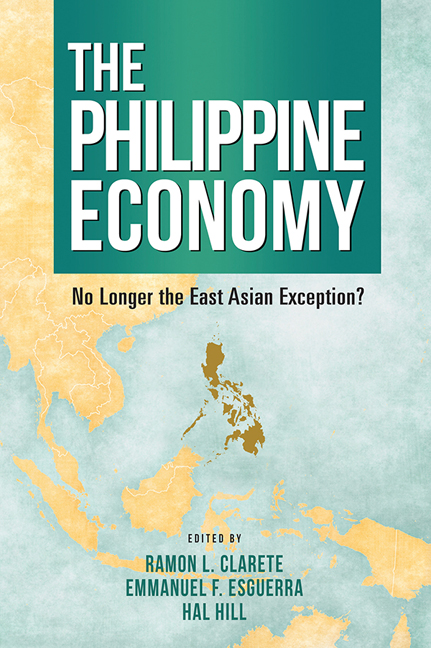Book contents
- Frontmatter
- Contents
- List of Figures
- List of Tables
- Foreword by Arsenio M. Balisacan
- Preface
- About the Contributors
- 1 The Philippine Economy: An Overview
- 2 Economic Growth and Poverty Reduction
- 3 Infrastructure and Urbanization
- 4 Education and Training
- 5 Universal Health Coverage, Health Security and Resilient Health Systems
- 6 Environmental Resources, Shocks and National Well-Being
- 7 Energy: Power Security and Competitiveness
- 8 Development Finance
- 9 Governance and Institutions
- Index
4 - Education and Training
Published online by Cambridge University Press: 12 February 2019
- Frontmatter
- Contents
- List of Figures
- List of Tables
- Foreword by Arsenio M. Balisacan
- Preface
- About the Contributors
- 1 The Philippine Economy: An Overview
- 2 Economic Growth and Poverty Reduction
- 3 Infrastructure and Urbanization
- 4 Education and Training
- 5 Universal Health Coverage, Health Security and Resilient Health Systems
- 6 Environmental Resources, Shocks and National Well-Being
- 7 Energy: Power Security and Competitiveness
- 8 Development Finance
- 9 Governance and Institutions
- Index
Summary
Introduction
The long-term economic success of a nation depends to a great extent on sustained increases in its endowment of human capital — the accumulated knowledge, skills and capacities of its workforce. This chapter focuses on the crucial role that investments in human capital, specifically in the education and training of the population, will play in maintaining the Philippine's development momentum.
The important role of education in development is well known. Nobel laureate Amartya Sen (2011) argued that “the elimination of ignorance, of illiteracy … and of needless inequalities in opportunities [is] to be seen as objectives that are valued for their own sake. They expand our freedom to lead the lives we have reason to value, and these elementary capabilities are of importance on their own” (p. 240). Indeed, limited access to education, particularly of poor households, consistently emerged as a major concern in the recent focused group discussions conducted for Filipino 2040 (see David 2015).
Education is not only an end in itself; it is also a means to enhance well-being by increasing an individual's productivity and therefore earnings. Incontrovertible evidence suggests that people with greater education and training have better employment opportunities and higher earnings.
Access to education can help lift poor households out of poverty by breaking the intergenerational cycle of poverty (HDN 2000). Poverty is perpetuated mainly because poorly educated parents, mired in low-paying occupations, lack the means to continue to send their children to school, effectively condemning them to low-productivity employment and, consequently, meagre earnings. To households earning subsistence incomes, the opportunity cost of sending their children to school — hence foregoing income from their children's labour — is too high. Studies have shown that dropout rates are higher in poor households where parents have low education. The obvious way out of this poverty trap is for children to acquire an education that allows them entry into higher paying jobs. This can happen if private entities or the government subsidize the cost of education of the children of poor households.
The benefits of education extend well beyond the well-being of those who receive it. Society also gains from the positive externalities of an educated citizenry. People with more education are more likely to be more civic-minded, better able to understand social and political issues, vote more wisely, obey the law, and adhere to the basic rules of good manners and conduct.
- Type
- Chapter
- Information
- The Philippine EconomyNo Longer The East Asian Exception?, pp. 151 - 189Publisher: ISEAS–Yusof Ishak InstitutePrint publication year: 2018

